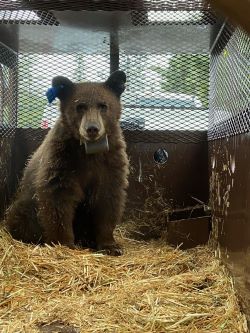Triplets released in Mariposa County

Plumas County release
Four orphaned bears were released back into the wild last week after spending the past six months at a wildlife rehabilitation facility in San Diego.
Three of the bears—triplets—were released back to national forest land in Mariposa County on April 14 just a few miles from where they were found last fall, when a bear presumed to be their mother was found shot dead nearby. The fourth bear, rescued from the Dixie Fire last year, was returned on April 15 to its home range in Plumas County. The black bears were born in winter 2020 and are now yearlings.
“We released them as far as we could from human-occupied areas to give them the best chance at living in the wild,” said CDFW biologist Mark Abraham, who coordinated the Mariposa County release. CDFW biologists George Harse and Tim Kroeker were also on the Mariposa County release team.
The bears were fitted with GPS collars which will track their movements and provide data that CDFW can use to inform wildlife management decisions.
“We hope to get useful data from the collars about where they go and what they do,” said Harse. “We’re curious to see how long the triplets stay together before going off on their own. Once bears disperse, they typically don’t hang out with family members.”
Black bears in California stay with their mothers for up to two years while learning to forage and survive. All four bears released last week were orphaned as cubs and didn’t have the opportunity to fully learn those skills. Since last fall the bears have been receiving care at San Diego Humane Society’s Ramona Wildlife Center.
CDFW Biologist Stacy Anderson, who coordinated the Plumas County release, was cautiously optimistic that the bears would succeed in their return to the wild.
“The cubs from Plumas County were brought in due to devastating impacts from the 2021 Dixie Fire. After receiving medical treatment and acquiring ample fat reserves they are now good candidates for release back to their native habitat,” said Anderson. CDFW biologist Sara Holm was also part of the Plumas County release team.
The public can report bear concerns to local law enforcement or to CDFW through its Wildlife Incident Reporting system. Public safety concerns should immediately be reported to law enforcement.
If you see a bear or bear cub, do not approach it. Adult bears, when out foraging, may leave offspring at a safe location for up to a day at a time. Seeing a bear cub by itself does not indicate that it is an orphan or that intervention is necessary.
For more information visit CDFW’s Keep Me Wild page on black bears: wildlife.ca.gov/Keep-Me-Wild/Bear
Media contact:
Ken Paglia, CDFW communications